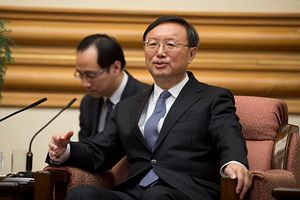Japanese Prime Minister Shinzo Abe and Chinese President Xi Jinping have yet to meet, but the real breakthrough in China-Japan relations has already occurred. On Friday, Chinese State Councilor Yang Jiechi and Japanese National Security chief Shotaro Yachi jointly issued a four-point consensus on improving China-Japan ties. The text is available from Xinhua and from Japan’s Ministry of Foreign Affairs (with some interesting differences in the English translations, which I’ll discuss below).
The first point was simply China and Japan’s pledge to “continue to develop a mutually beneficial relationship based on common strategic interests.” Both sides reconfirmed their commitment to the “four basic documents” issued between China and Japan, which have served as the basis for China-Japan relations since the normalization of diplomatic ties in 1972. The four documents are the China-Japan Joint Statement of 1972, the China-Japan Treaty of Peace and Friendship of 1978, the China-Japan Joint Declaration of 1998 and a joint statement on advancing relations in 2008. According to Tang Jiaxuan, the head of the China-Japan Friendship Association, the “spirit of the four documents includes learning from history, peaceful coexistence, mutual respect, friendship for generations, mutually beneficial cooperation and common development.”
Second, both sides reached “some agreement” (“some recognition,” according to the Japanese translation) on overcoming political difficulties in a spirit of “facing history squarely and looking forward to the future.” This is as close as China could get to fulfilling its demand for Japan to adopt a “proper attitude” toward history and stop “whitewashing Japan’s militarist past.” As with each point of consensus, there’s compromise worked into the language itself. China can satisfy itself with an agreement on “facing history squarely” while Japan can point to the clause on “looking forward to the future.” The caveat that China and Japan had only reached “some” consensus on this point indicates how far apart the two sides really are on historical issues; Japan’s use of “some recognition” rather than “some agreement” implies even greater distance.
Third, and perhaps most importantly, China and Japan addressed the controversial issue of the Senkaku/Diaoyu Islands. Japan administers the islands and does not officially recognize that they are also claimed by China, a point of contention with Beijing. Friday, China and Japan “acknowledged that different positions exist between them regarding the tensions which have emerged in recent years” over the disputed islands. The Japanese translation waters this down a bit, using the less-official term “views” instead of “positions.”
Notice here that the essential question of the territorial dispute is not mentioned at all. China and Japan are not “agreeing to disagree” on the territorial issue – they are agreeing that different stances exist on the cause behind recent tensions. This may seem like a minor point, but it’s a carefully crafted diplomatic compromise. The consensus here gives China just enough to justify a thawing of diplomatic ties after its long-held hardline stance that Japan must make certain concessions for the relationship to move forward. Japan, however, avoids actually acknowledging that China claims the Senkaku/Diaoyu Islands. Previous media reports that Abe would agree to acknowledge differing views on the Diaoyu/Senkaku dispute were right in general but wrong in their specifics – Japan has not acknowledged China’s competing claim to the islands. In fact, the Japanese Foreign Ministry website on the Senkaku Islands still states that “there exists no issue of territorial sovereignty to be resolved concerning the Senkaku Islands.” Insetad, Japan merely recognized that China holds “different views” over how recent tensions in the area arose.
Both China and Japan promised to use “dialogue and consultation” to prevent the situation in the East China Sea from boiling over in the future. The statement issued Friday mentioned the establishment of a “crisis management mechanism” (“mechanisms,” plural, in the Chinese version) to help keep incidents in the disputed region from getting out of hand. It’s a promising step forward, if it comes to fruition.
Fourth, China and Japan agreed to “gradually resume political, diplomatic and security dialogue through various multilateral and bilateral channels.” This resumption of dialogue has already happened behind the scenes – the four-point consensus itself is evidence of that. In releasing the document, both sides confirmed that they had held several rounds of “quiet” diplomatic talks in recent months, with the ultimate goal of restoring the bilateral relationship. Now Beijing and Tokyo have officially agreed to resume talks on a formal level, a marked sign of progress.
That will begin this weekend, at the APEC summit. Chinese Foreign Ministry spokesperson Qin Gang confirmed that China’s foreign minister and commerce minister will meet with their Japanese counterparts. Qin noted, however, that the meetings had been arranged “at the request of the Japanese side.” There was no announcement on a potential Xi Jinping-Shinzo Abe meeting from the Chinese side, but Japanese media are reporting that the two leaders are likely to hold a “brief and informal” meeting on the sidelines of the APEC summit.
While Chinese media continued to be coy about a Xi-Abe meet-up, a commentary in Xinhua praised the “visibly productive meeting” between Yang Jiechi and Shotaro Yachi as “an encouraging icebreaker that has been painfully overdue.” Even while praising progress, however, Xinhua called for patience: “whether a China-Japan summit would take place or not, the ice trapping bilateral relations is too thick to melt in a day or two.” In other words, the four-point consensus is the beginning, not the end, of a “thawing season” in China-Japan ties.
































